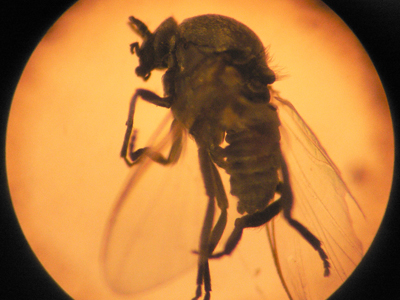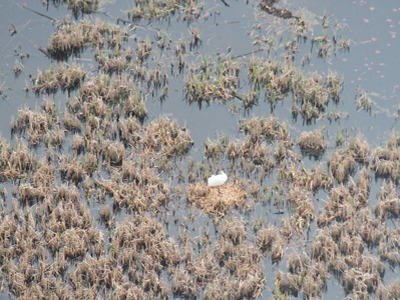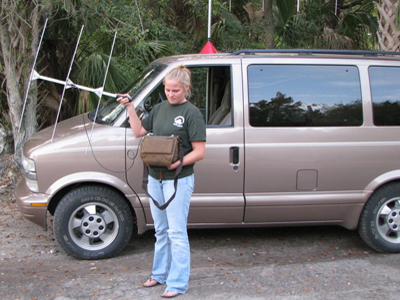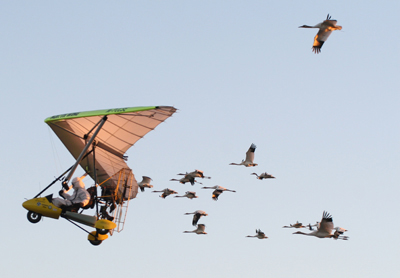 ICF’s Field Ecology Department (FED) staff are continuing their study of nesting Whooping Cranes in central Wisconsin and factors that may lead to nest abandonment. One hypothesis is that biting black flies may be harassing the cranes, to the extent that the birds cannot remain on their nest for the full 30-day incubation period. Following is an account of our spring research involving black flies, insect traps and fake nests, and planes!
ICF’s Field Ecology Department (FED) staff are continuing their study of nesting Whooping Cranes in central Wisconsin and factors that may lead to nest abandonment. One hypothesis is that biting black flies may be harassing the cranes, to the extent that the birds cannot remain on their nest for the full 30-day incubation period. Following is an account of our spring research involving black flies, insect traps and fake nests, and planes!
Tag: Reintroduction
Spring Migration is Underway for “Class of 2011” Whooping Cranes
 The Whooping Crane Eastern Partnership (WCEP), an international coalition of public and private groups that is reintroducing Whooping Cranes to eastern North America, is pleased to report that last year’s “Class of 2011” Whooping Cranes have all begun their spring migration north.
The Whooping Crane Eastern Partnership (WCEP), an international coalition of public and private groups that is reintroducing Whooping Cranes to eastern North America, is pleased to report that last year’s “Class of 2011” Whooping Cranes have all begun their spring migration north.
The Elusive Whooping Crane #2-11
![]() ICF’s Eva Szyszkoski, Tracking Field Manager for the Whooping Crane Eastern Partnership (WCEP), has been in Alabama banding the group of nine ultralight-led Whooping Cranes, which were released at Wheeler National Wildlife Refuge earlier this month. Last week, Eva was tracking a tenth Whooping Crane (#2-11), who had separated from the other nine juvenile cranes during migration in Wisconsin last October and wintered in Florida. Following is Eva’s report on her attempt to re-capture #2-11 to replace it’s radio transmitter (and news that spring migration has started!).
ICF’s Eva Szyszkoski, Tracking Field Manager for the Whooping Crane Eastern Partnership (WCEP), has been in Alabama banding the group of nine ultralight-led Whooping Cranes, which were released at Wheeler National Wildlife Refuge earlier this month. Last week, Eva was tracking a tenth Whooping Crane (#2-11), who had separated from the other nine juvenile cranes during migration in Wisconsin last October and wintered in Florida. Following is Eva’s report on her attempt to re-capture #2-11 to replace it’s radio transmitter (and news that spring migration has started!).
Ultralight-led Whooping Cranes will be Released on Wheeler NWR
 Nine juvenile Whooping Cranes on their first ultralight-led migration south will be taken to Wheeler National Wildlife Refuge (NWR) in Morgan County, Ala. in the next few days. The nine Whooping Cranes will be placed in travel enclosures and loaded onto vehicles as soon as possible. They will be driven about 70 miles from Winston County, Ala., to Wheeler NWR. The cranes will be temporarily housed in a secure pen, during which time they will be fitted with identification bands and tracking transmitters. The young birds will then be released in the company of other Whooping Cranes that have been wintering at the refuge.
Nine juvenile Whooping Cranes on their first ultralight-led migration south will be taken to Wheeler National Wildlife Refuge (NWR) in Morgan County, Ala. in the next few days. The nine Whooping Cranes will be placed in travel enclosures and loaded onto vehicles as soon as possible. They will be driven about 70 miles from Winston County, Ala., to Wheeler NWR. The cranes will be temporarily housed in a secure pen, during which time they will be fitted with identification bands and tracking transmitters. The young birds will then be released in the company of other Whooping Cranes that have been wintering at the refuge.




